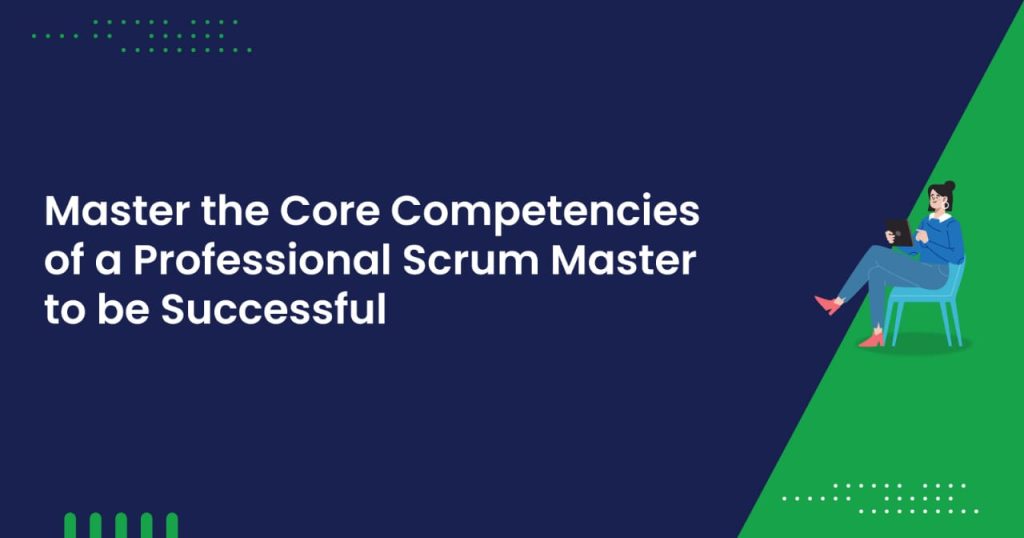
In recent times, all we can perceive is the fact that the role of a Scrum Master is evolving, and it is much faster than what one can ever imagine. The time has passed when Scrum Masters were restricted to conventional roles and responsibilities, like schedulers of Scrum and updaters of Jira boards. Missing out on factors like upgrading yourself and the way you can bring value to the teams, organization and business can throw you out of the race. In such scenarios, it becomes mandatory to understand what exactly it takes to become a successful Scrum Master. More often, professionals kickstart their upskilling with the help of various professional courses and training.
In this topic of discussion, we are all set to take a deeper dive into the concepts, like what it seems like to be a professional scrum master and what core competencies an individual needs to become a successful one in the tech industry.
Professional Scrum Masters- Who Are They?
A ‘Professional Scrum Master’ is an individual who holds the potential to demonstrate the knowledge and thorough understanding of Scrum and its application within real-world circumstances. Earning a certification adds value and is related to the abilities of the professionals to demonstrate the knowledge required to achieve it. Considering these factors, the assessments of PSM Certification training prove to be a more valuable alternative for Scrum.
It’s time to explore a wide range of core competencies for individuals who look forward to thriving in this domain.
Core Competencies Of A Professional Scrum Master
The following are some of the core competencies that a professional scrum master should have to become successful:
Deeper Understanding And Ability To Apply The Scrum Framework
As a Scrum practitioner, learning about the Scrum framework and having in-depth knowledge is the first step to developing core competencies. As a part of Agile methodologies, this step is considered to be most crucial because it assists teams and individuals to deliver value collaboratively. Scrum provides a structure to integrate the framework among the teams and include all those practices as per the circumstances to build a process. The sole ideology of Scrum is based on the pillars known as empiricism, self-management, and consistent improvement. The focus areas that revolve around this competency include Empiricism, Scrum Values, Scrum Team, Events, Artifacts, Done, and Scaling.
Development Of People & Team
The conventional mode of management believed that tasks like people and team development are a part of the job role of the team’s manager. However, the Scrum framework provides a specific responsibility to Scrum Masters to support and provide guidance to the team members. Scrum is all about working together and delivering products with higher agility. The members of the Scrum Team adopt different stances while working with people within and outside the team. In the meantime, this is to be noted that team development is not the sole responsibility of a Scrum Master. The teams under the Scrum framework are self-managing and every member is responsible for continuous improvement with the help of techniques that ‘develop people and teams’. In this regard, the focus areas of this competency are Self-Managing Teams, Facilitation, Leadership Styles, Coaching, Mentoring, and Teaching.
Managing Projects/Products With Agility
To provide value to the end-users and the organization, Scrum Teams manage the product with agility, where the product has a clear goal, stakeholders and users, and moreover, the product is measurable. Managing projects or products with agility delivers results that are valuable for generating business revenues. The wider the range of flexibility, the better the scope of adaptation and responsiveness to the changes, with more transparent investment decisions for product development.
When it comes to managing products with agility, a clear and understandable vision of the product plays a vital role, as it promotes appropriate alignment of product development with the business strategy and company goals. This also helps in delivering value that meets customer satisfaction and stakeholder expectations, along with consistent improvement, as needed. This product value holds enormous considerations like transparency, value-based decisions across the organization and value-driven approaches.
One of the most vital principles that is rooted deep within the Agile methodology is that the alignment between Product Vision and Product Value is quite iterative and incremental. This can be managed with the help of effective Product Backlog refinement. This process involves inputs and collaboration from the Scrum Teams, stakeholders and customers, requiring intense brainstorming and evolution of techniques that can ensure transparency at different levels, as needed. This iterative and incremental approach is also applicable when it comes to Forecasting and Planning, as it assists in managing changes and complexity, along with the realities that lie as a part of the business obligations. All these considerable factors eventually lead to the development and delivery of a valuable product along with relevant enhancements.
It can be implied that during effective management of projects or products with Agility, the key focus areas include Product Vision, Product Value, Business Strategy, Forecasting and Release Planning, Product Backlog Management and Stakeholders and Customers.
Development and Delivery of Products In A Professional Manner
Professionals holding PSM 2 Certification are highly eligible to utilize Professional Scrum results for delivering high-quality products that are iterative and incremental. These high-quality products are tailored exclusively to meet the requirements of the stakeholders and customers, offering flexibility for value realization for the expected changes. In order to ensure this possibility, it is mandatory for a product to be developed in a certain manner. With this regard, there are certain focus areas that support this competency like Emergent Software Development, Optimizing Flow, Managing Technical Risks, Continuous Integration, Continuous Quality and Continuous Delivery.
The core ideology behind the management of all the tasks or user stories throughout the lifespan of product development is all about reducing the number of cycle times and eliminating waste. This is also important as it can assist in integrating different teams, platforms and activities with the help of set tools and processes. The processes and tools like Focus Area, Continuous Integration and Continuous Delivery offer a direction to deliver value on a consistent basis along with the learnings.
More often, Scrum Team(s) make use of Emergent Software Development ideology for a completely structured, especially detailed and well-designed methodology of product development. However, the decisions are not made prior but rather are made when required. More detailed decisions are taken on the basis of the overall framework so that the product meets all the organizational requirements and parameters.
Throughout the lifespan of the production process, it is crucial for the Scrum Teams to keep track of the Optimizing Flow and Continuous Quality. This can satisfy its end users where the product is fully integrated, tested and in a situation of release, known as ‘Done’ in a continuous manner. This production cycle of the partial ‘Done’ product has to go through continuous development while Managing Technical Risk. It can be considered as one of the critical steps because it can challenge the team’s ability to adapt to changes, responsiveness, speed of productivity and thereby the company’s agility.
Despite being naturally tangible in nature, it is mandatory for Scrum Teams to develop and deliver products in a professional manner that can facilitate communication, collaboration and stakeholder engagement.
Evolving An Agile Organization
The outrageous demand for agility in the tech industry has eventually led to the rise of Scrum Teams within the organization, leading to the evolution of an agile environment. This evolution can be successful if the Scrum Teams have a reduced amount of friction and absolute freedom, along with a sense of self-management. This can help Scrum Teams to create solutions that are closest to the business goals and end-users’ satisfaction.
In order to support this agile environment, the organizational structure, incentives and practices related to human resources and governance must incorporate agility.
Some of the focus areas of this competency include Portfolio Planning, Organizational Design & Structure and Evidence-Based Management.
Final Notes
The roles and responsibilities of a Professional Scrum Master hold enormous significance within the agile environment. Skills like deeper understanding and the ability to apply the Scrum framework, development of people & teams, evolving an Agile organization, etc., can make a professional stand out from the crowd. Having a credential like the Professional Scrum Master Certification Training from the authorized and globally recognized training partners.
